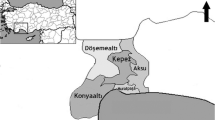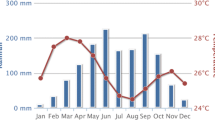Abstract
Wildlife hosts many pathogens of economic importance and is considered as a reservoir of important tick-borne diseases of livestock in southern Africa. The species composition of ticks parasitizing buffalo (Syncerus caffer), impala (Aepyceros melampus) and elephant (Loxodonta africana) was investigated in five protected parks in the Zambezi valley, Zimbabwe. A total of 1104 adult ticks was collected from 75 adult animals comprising five buffaloes, five elephants and five impalas drawn from five protected wildlife parks. Five tick species belonging to two genera were recovered, with Rhipicephalus decoloratus being the most prevalent species in all the three animal groups. Amblyomma hebraeum was only recovered from buffaloes whereas Rhipicephalus zambeziensis was recovered from buffalos and elephants. Significant differences in mean tick species distribution and concentration were observed amongst the wildlife parks and these appeared to be influenced by the number of hosts in each park. The study revealed that buffaloes are the major host of R. decoloratus in the Zambezi valley. The presence of these ixodid ticks within the Zambezi valley may have significant ecological and economic impacts on wildlife conservation, domestic animals and human health.

Source: Mana Pools national park general management plan unpublished 2008

Similar content being viewed by others
References
Allsop BA (2010) Natural history of Erlichia ruminantium. Vet Parasitol 167:123–135
Anderson K, Ezenwa VO, Jolles AE (2013) Tick infestation patterns in free ranging African buffalo (Syncercus caffer): effects of host innate immunity and niche segregation among tick species. Int. J. Parasitol. Parasit. Wildl. 2:1–9
Daszak P, Cunningham AA, Hyatt AD (2000) Emerging infectious diseases of wildlife-threats to biodiversity and human health. Science 287:443–449
Department of Meteorological Services (1981) Climate handbook of Zimbabwe. Government Printers, Salisbury
du Toit JT (1990) Home range—body mass relations: a field study on African browsing ruminants. Oecologia 85:301–303
Du Toit R (1993) Reconnaissance vegetation survey of the Chewore-Angwa-Kanyemba area of the Zambezi valley, Zimbabwe. Kirkia 14(1):61–77
Eygelaar D, Jori F, Mokopasetso M, Sibeko KP, Collins NE, Vorster I, Troskie M, Oosthuizen MC (2015) Tick-borne haemoparasites in African buffalo (Syncerus caffer) from two wildlife areas in Northern Botswana. Parasite Vector 8:2–11
Food and Agriculture Organisation of the United Nation (FAO) (1984) Ticks and tick-borne disease control. A practical field manual, vol 1. Tick control. FAO, Rome
Fowler M, Mikota SK (2008) Biology, medicine and surgery of elephants. Wiley, New York
Fyumagwa RD, Simmler P, Meli ML, Hoare R, Hoffman-Lehmann R, Latz H (2009) Prevalence of Anaplasma marginale in different tick species from Ngorongoro Crater, Tanzania. Vet Parasitol 161:154–157
Gallivan GJ, Culverwel J, Girdwood R, Surgeoner GA (1995) Ixodid ticks of impala (Aepyceros melampus) in Swaziland: effect of age class, sex, body condition and management. S Afr J Zool 30(4):178–186
Grobler JH (1981) Parasites and mortality of sable Hippotragus niger niger (Harris 1838) in the Matopos Zimbabwe. National Parks Board of Trustees Department of Research and Information Private Bag X66 Cradock 5880
Horak IG, Potgieter FT, Walker JB, De Vos V, Boomker J (1983) The ixodid tick burdens of various large ruminant species in South African nature reserves. Onderstepoort J Vet Res 50:221–228
Horak IG, Golezardy H, Uys AC (2007) Ticks associated with the three largest wild ruminant species in southern Africa. Onderstepoort J Vet Res 74:231–242
Horak IG, Heyne H, Williams R, Gallivan GJ, Spickett AM, Bezuidenhout JD, Estrada-Pena A (2018) The ixodid ticks (Acari: Ixodidae) of Southern Africa. Springer, Berlin
Lawrence JA, Norval RAI (1979) Control of heart water in Zimbabwe Rhodesia. Rhod Vet J 10:28–40
Lightfoot CJ (1978) The feeding ecology of giraffe (Giraffa camelopardalis L.) in the Rhodesian middleveld as a basis for the determination of carrying capacity. Unpublished M.Sc. thesis, University of Rhodesia
Lightfoot CJ, Norval RAI (1981) Tick problems in Wildlife in Zimbabwe. I. The effects of tick parasitism on wild angulates. S Afr J Wildl Res 11:41–45
Lynen G, Zeman P, Bakuname C, Di GG, Mtui P, Sanka P, Jongejan F (2008) Shifts in the distributional ranges of Boophilus ticks in Tanzania: evidence that a parapatric boundary between Boophilus microplus and B. decoloratus follows climate gradients. Exp Appl Acarol 44:147–164
Mackie CS (2002) Aerial census of elephants and other large herbivores in the Zambezi valley, Zimbabwe. Department of National Parks and Wildlife Management, WWF-SARPO occasional paper, no. 2, pp 13–51
Mavedzenge BZ, Mehenehene J, Murimbarimba F, Scoones I (2006) Changes in the livestock sector in Zimbabwe following land reform: the case of Masvingo province. http://www.ids.ac.uk. Accessed 20 Jan 2018
Mejia TA, Fuente J (2006) Risks associated with ectoparasites of wild mammals in the Department of Quindío, Colombia. Int J Appl Res Vet Med 4(3):187–192
Munang’andu HM, Siamudaala V, Matandiko W, Mulumba M, Nambota A, Munyeme M, Mutoloki S, Nomga H (2009) Detection of Theileria parva antibodies in the African buffalo (Syncerus caffer) in the livestock-wildlife interface areas of Zambia. Vet Parasitol 166:163–166
Munang’andu HM, Siamudaala VM, Munyeme M, Nalubamba KS (2012) Detection of parasites and parasitic infections of free-ranging wildlife on a game ranch in Zambia: a challenge for disease control. J Parasitol Res 2012:296475. https://doi.org/10.1155/2012/296475
Ndhlovu DN, Makaya PV, Penzhorn BL (2009) Tick infestation, and udder and teat damage in selected cattle herds of Matabeleland South, Zimbabwe. Onderstepoort J Vet Res 76:235–248
Norval RAI, Lightfoot CJ (1982) Tick problems in wildlife in Zimbabwe: factors influencing the occurrence and abundance of Rhipicephalus appendiculatus. Zimb Vet J 13:11–20
Norval RAI, Lawrence JA, Young AS, Perry BD, Dolan TT, Scott J (1991) Theileria parva: influence of vector, parasite and host relationships on the epidemiology of theilerosis in Southern Africa. Parasitol 102:347–356
Norval RAI, Andrew HR, Meltzer M (1992) Seasonal occurrence of the bont tick (Amblyomma hebraeum) in the southern Lowveld of Zimbabwe. Exp Appl Acarol 13(2):81–96
Pascucci I, Dondona AC, Camma C, Marracci M, Domenico M et al (2011) Survey of ixodid ticks and two tick-borne pathogens in African buffaloes, Syncerus caffer, from Caprivi Srip, Namibia. J Zoo Wildl Med 42(4):634–640
Peter TF, Perry BD, O’Callaghan CJ, Shumba W, Madzima W, Burridge MJ, Malan SM (1998) Distributions of the vectors of heartwater, Amblyomma hebraeum and Amblyomma variegatum (Acari: Ixodidae) in Zimbabwe. Exp App Acarol 22:725–740
Sungirai M, Madder M, Moyo DZ, De Clercq D, Abatih EN (2015) An update on the ecological distribution of the Ixodidae ticks in Zimbabwe. Exp Appl Acarol 66:269–280
Sungirai M, Abatih EN, Moyo DZ, De Clercq P, Madder M (2017) Shifts in the distribution of ixodid ticks parasitizing cattle in Zimbabwe. Med Vet Entomol 31(1):78–87
Uilenberg G (1994) Significance of tick-borne haemoparasitic diseases to animal health in the tropics. In: Proceedings of FAO expert consultation on the use of applicable biotechnological methods for diagnosing haemoparasites. Merida, Mexico. 4–6 October 1993. FAO of the United Nations, Rome, pp 7–28
Walker AR, Bouattour R, Camicas JL, Estrada-Peña A, Horak IG, Latif AA, Pegram RGA, Preston PM (2003) Ticks of domestic animals in Africa: a guide to identification of species. Bioscience Reports. Edinburgh Scotland, UK
Ward R (1975) Records of big game, 16th edn. Rowland Ward, London
Wei L, Wang X, Wang C, He H (2010) A survey of ectoparasites from wild rodents and Anourosorex squamipes in Sichuan Province, southwest China. J Ecol Nat Environ 2(8):160–166Z
ZNPWMA (2009) Mana Pools national park: general management plan. Zimbabwe National Parks and Wildlife Authority, Harare
Acknowledgements
The authors are grateful to the Zimbabwe Parks and Wildlife Management Authority for giving us permission to collect ticks from wildlife in the protected park estates and to Midlands State University Research Board (Grant No. 2015/3) for the financial assistance rendered for this study to be successful.
Author information
Authors and Affiliations
Corresponding author
Ethics declarations
Conflict of interest
The authors declare that there is no conflict of interest in this study.
Rights and permissions
About this article
Cite this article
Moyo, D.Z., Chakuya, J. & Sungirai, M. Ixodid ticks of African buffalo (Syncerus caffer), impala (Aepyceros melampus) and elephant (Loxodonta africana) in five protected park estates in the Zambezi valley, Zimbabwe. Exp Appl Acarol 75, 409–417 (2018). https://doi.org/10.1007/s10493-018-0275-6
Received:
Accepted:
Published:
Issue Date:
DOI: https://doi.org/10.1007/s10493-018-0275-6




